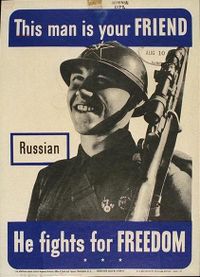In 1979, however, the Soviet Army intervened in a civil war raging in Afghanistan. The Soviet Army came to back a Soviet-friendly secular government threatened by Muslim fundamentalist guerillas equipped and financed by the United States. Technically superior, the Soviets did not have enough troops to establish control over the countryside and to secure the border. This resulted from hesitancy in the Politburo, which allowed only a "limited contingent", averaging between 80,000 and 100,000 troops. Consequently, local insurgents could effectively employ hit-and-run tactics, using easy escape-routes and good supply-channels. This made the Soviet situation hopeless from the military point of view (short of using "scorched earth" tactics, which the Soviets did not practise except in World War II in their own territory). The understanding of this made the war highly unpopular within the Army. With the coming of glasnost, Soviet media started to report heavy losses, which made the war very unpopular in the USSR in general, even though actual losses remained modest, averaging 1670 per year. The war also became a sensitive issue internationally, which finally led Gorbachev to withdraw the Soviet forces from Afghanistan. The "Afghan Syndrome" suffered by the Army parallels the American Vietnam Syndrome trauma over their own lost war in Vietnam.
 And lets not forget that it was in the Post Soviet internecine civil war period; 1990-1999 that lead the Taliben to take power. Because the Americans cut and ran, leaving the country to the Mujahedin, War Lords, and Drug Lords. Not our problem said the CIA who conducted the anti-Soviet war.
And lets not forget that it was in the Post Soviet internecine civil war period; 1990-1999 that lead the Taliben to take power. Because the Americans cut and ran, leaving the country to the Mujahedin, War Lords, and Drug Lords. Not our problem said the CIA who conducted the anti-Soviet war.
One long-term effect of the Soviet invasion and pull-out was the establishment of a weak state full of religious hatred and hatred of richer nations: a breeding ground for terrorism. Though supplying the Afghan resistance with American guns and anti-aircraft missiles seemed like a good idea for the US in the 1980s, and was the reason for the Soviets’ defeat, now as the US invades, they are met with their own guns. The significance of the sophisticated guns has yet to be determined. In light of the US involvement today in Afghanistan after the September 11th terrorist attacks, it is especially important to understand the history of the Soviet's involvement there so we can avoid making the same mistakes.
The Soviet Invasion of Afghanistan in 1979: Failure
of Intelligence or of the Policy Process?
1989–1991, after the official Soviet withdrawal from Afghanistan,
when both the Soviets and the US nevertheless continued to support their
proxies in the Afghan conflict. The group also considered the consequences
of American policy decisions to withdraw from engagement in Afghanistan;
consequences which not only gave free license to years of internal Afghan
turmoil, but profoundly impacted US strategic and security interests as well.
And it makes for a great movie too. Not like all these 9/11 Memorial TV and Movie shows but the real reason for 9/11; the CIA failure in Afghanistan. All else is conspiracy theories. Osama bin Laden could not have attacked America if America had not destabilized Afghanistan in the first place. And five years after ousting the Taliban we are still no better off.



